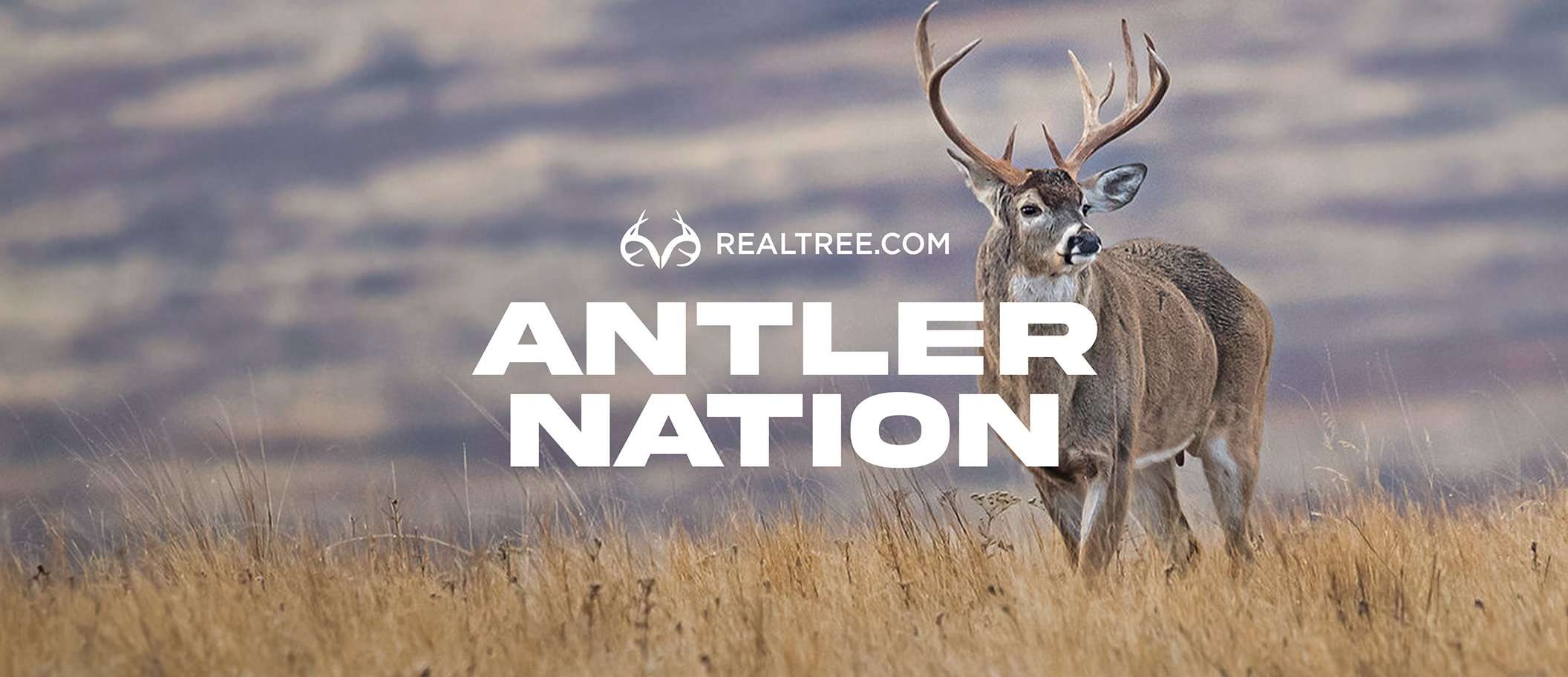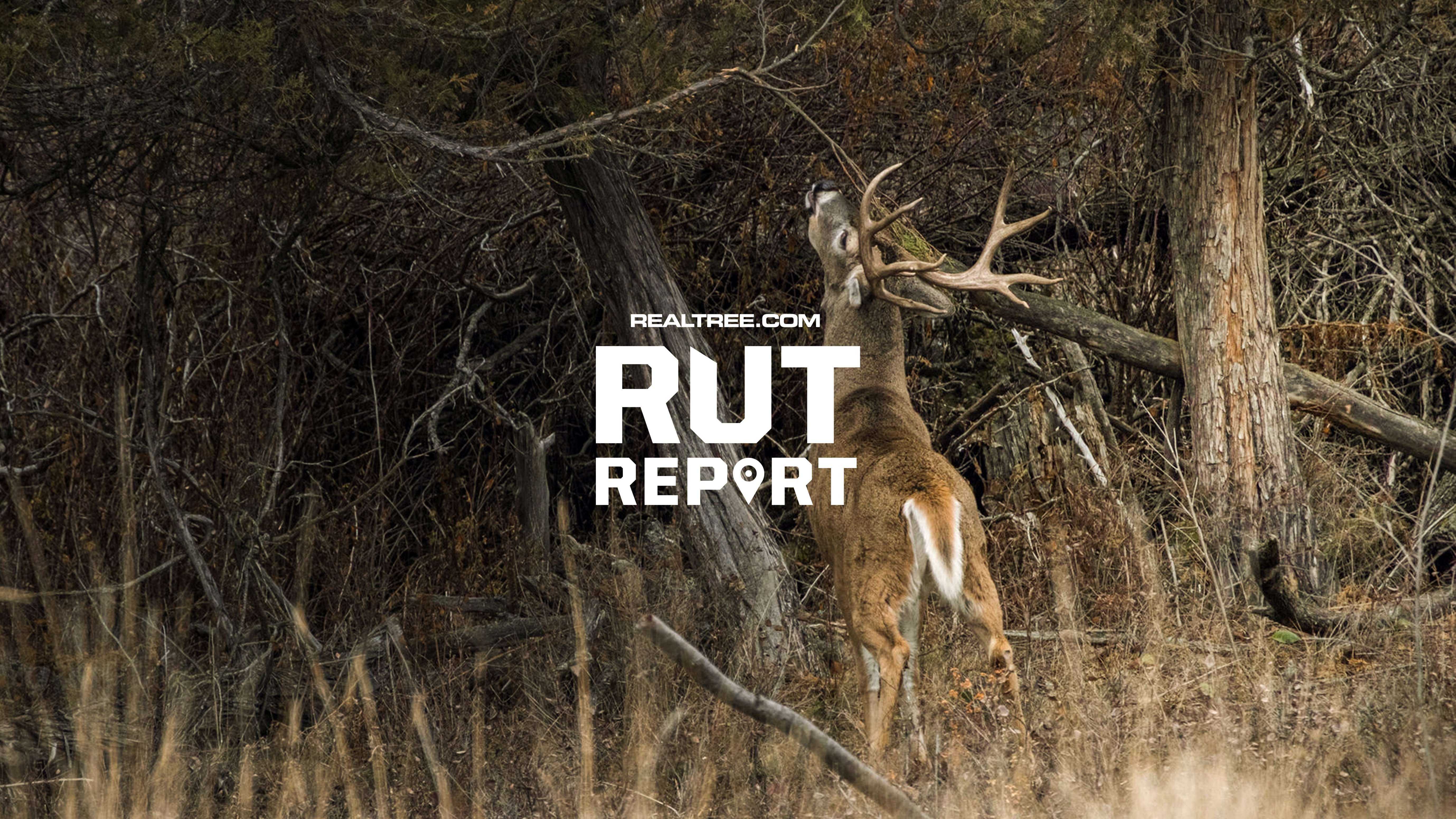A revolutionary stocking program injected new life into Volunteer State bass fishing, but anglers wonder if continuing efforts will produce more widespread results
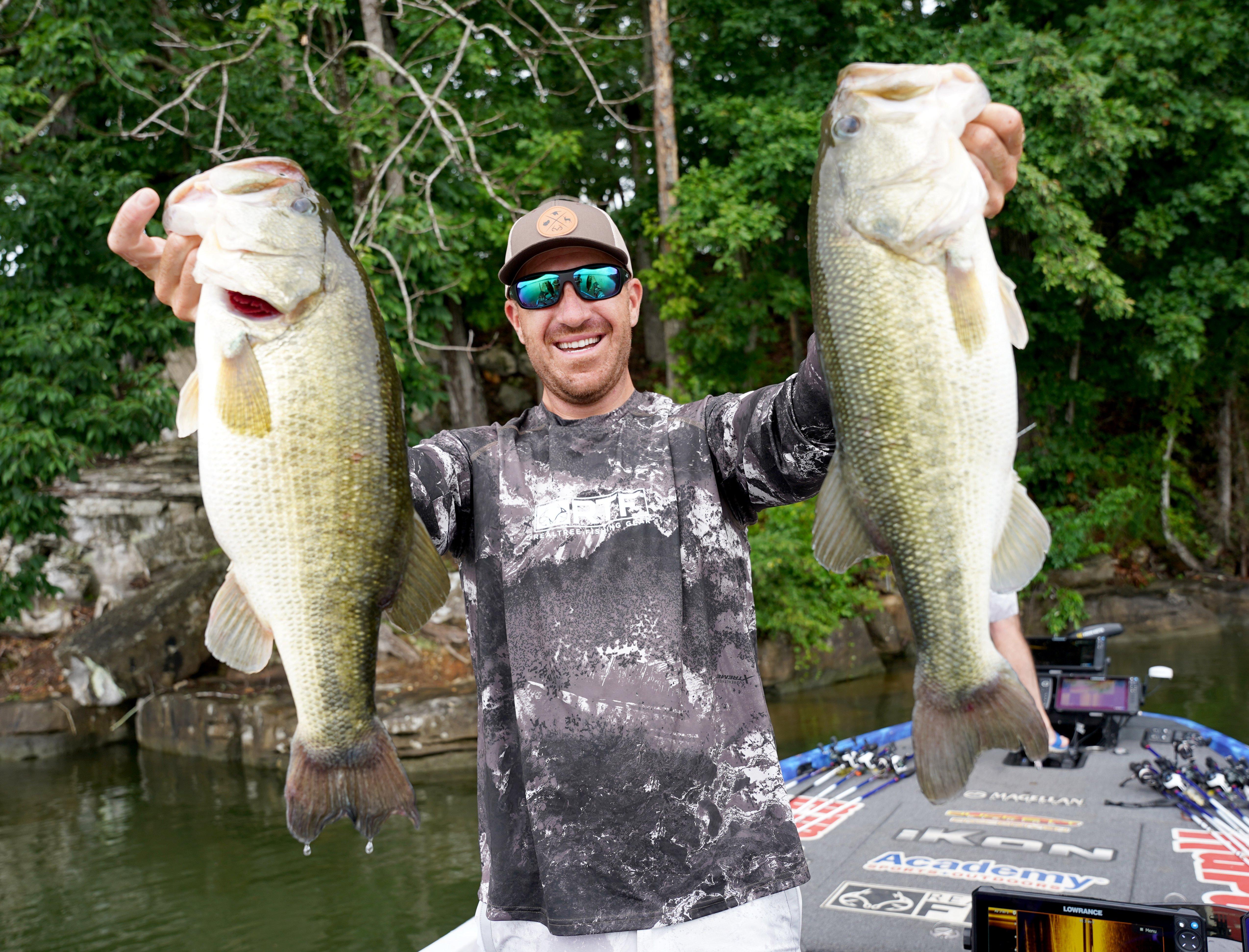
Jacob Wheeler, ranked as the No. 1 professional bass angler in the world by BassFan.com, shows off two nice largemouth bass he caught in Chickamauga Lake. It appears that a Florida bass stocking program in several Tennessee lakes is paying off as more anglers reel in big fish.
Innovative stocking efforts with Florida bass on Tennessee’s Chickamauga Lake have helped revitalize the once-sagging fishery and even led to a new state-record largemouth. The effort has been so successful that the state expanded the stocking program to several other lakes 10 years ago.
Of course, anglers are anxious to learn if the effort is working. Early results are encouraging, but officials caution that folks should be patient.
FLORIDA BASS HISTORY IN TENNESSEE
This story actually begins 25 years ago, in 2000. That’s when Bobby Wilson, then the assistant chief of the Fisheries Division for the Tennessee Wildlife Resources Agency, spearheaded the stocking of Florida bass fingerlings in Chickamauga Lake, one of the nine major reservoirs on the Tennessee River.
Chickamauga Lake was a great bass fishery until the 1990s, when the lake experienced a massive die-off of Eurasian milfoil, the primary aquatic vegetation in the reservoir, which had helped foster excellent bass fishing. After the milfoil die-off, some blamed the Tennessee Valley Authority’s aquatic weed eradication program, which focused almost exclusively on shoreline recreation areas. However, the agency said it would be impossible to completely eradicate milfoil throughout the lake even if it wanted to. Studies never pinned the blame on one factor leading to the die-off. But with the milfoil gone, the bass fishery declined quickly.
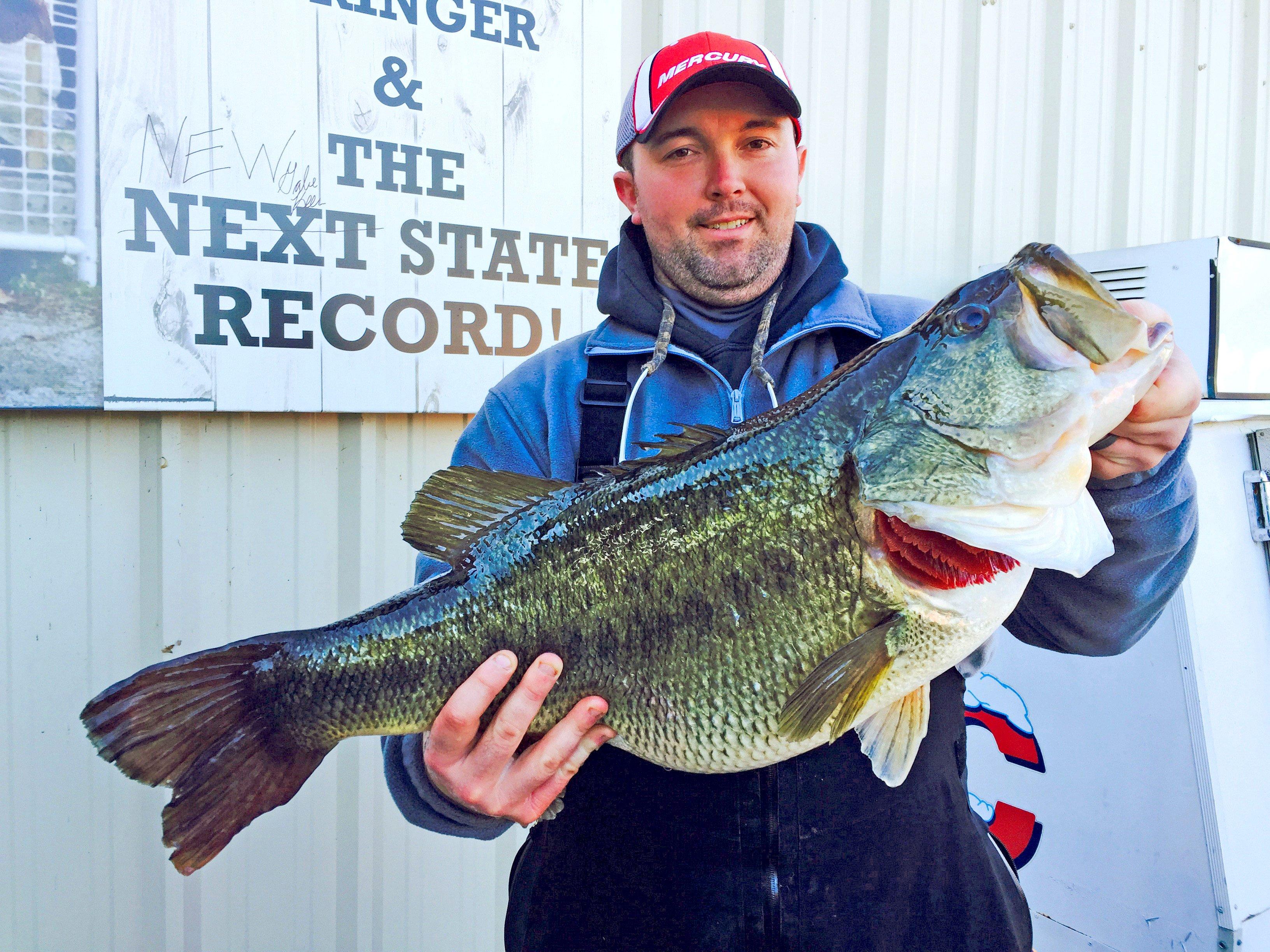
On Feb. 13, 2015, Gabe Keen caught the new Tennessee state-record largemouth bass, which weighed 15.3 pounds. DNA analysis proved the huge fish was a product of the state wildlife agency’s Florida bass stocking program in Chickamauga Lake. Photo by Richard Simms.
At the time, well-known bass pro Andy Morgan said, “I’ve been all over the United States fishing. My home lake right here was the best bass lake in the country. But now, my dad, Mark Morgan, who was a real good fisherman on this lake, doesn’t even fish. He just got kind of fed up with it.”
Facing public pressure about the declining bass fishery, TWRA sought help. It planted cypress trees to improve habitat about the same time as the idea to stock Florida bass fingerlings was born.
Don’t Miss: The Best Tactics for Wintertime Crappie Fishing
“This stocking isn’t necessarily intended to increase the number of bass in Chickamauga but to improve the quality,” said Bill Reeves, then-TWRA chief of fisheries.
HOW DOES IT HELP?
Florida bass are a genetic subspecies with the potential to grow larger than Tennessee’s native bass. Tennessee is on the northern edge of the climate zone with a growing season capable of producing trophy-size bass. Biologists hoped the introduced Florida bass genes would result in faster growth rates and potentially larger fish.
It was a slow process, but after 10 years, the program proved its worth, with regular reports of anglers catching occasional largemouth bass weighing 10-plus pounds. Then in February 2015, Gabe Keen caught a 15-pound, 3-ounce largemouth from Chickamauga Lake, breaking the Tennessee Largemouth State Record, which had stood for almost 60 years. DNA tests on Keen’s fish revealed it was an F-1 hybrid cross between a Florida bass and a native largemouth.
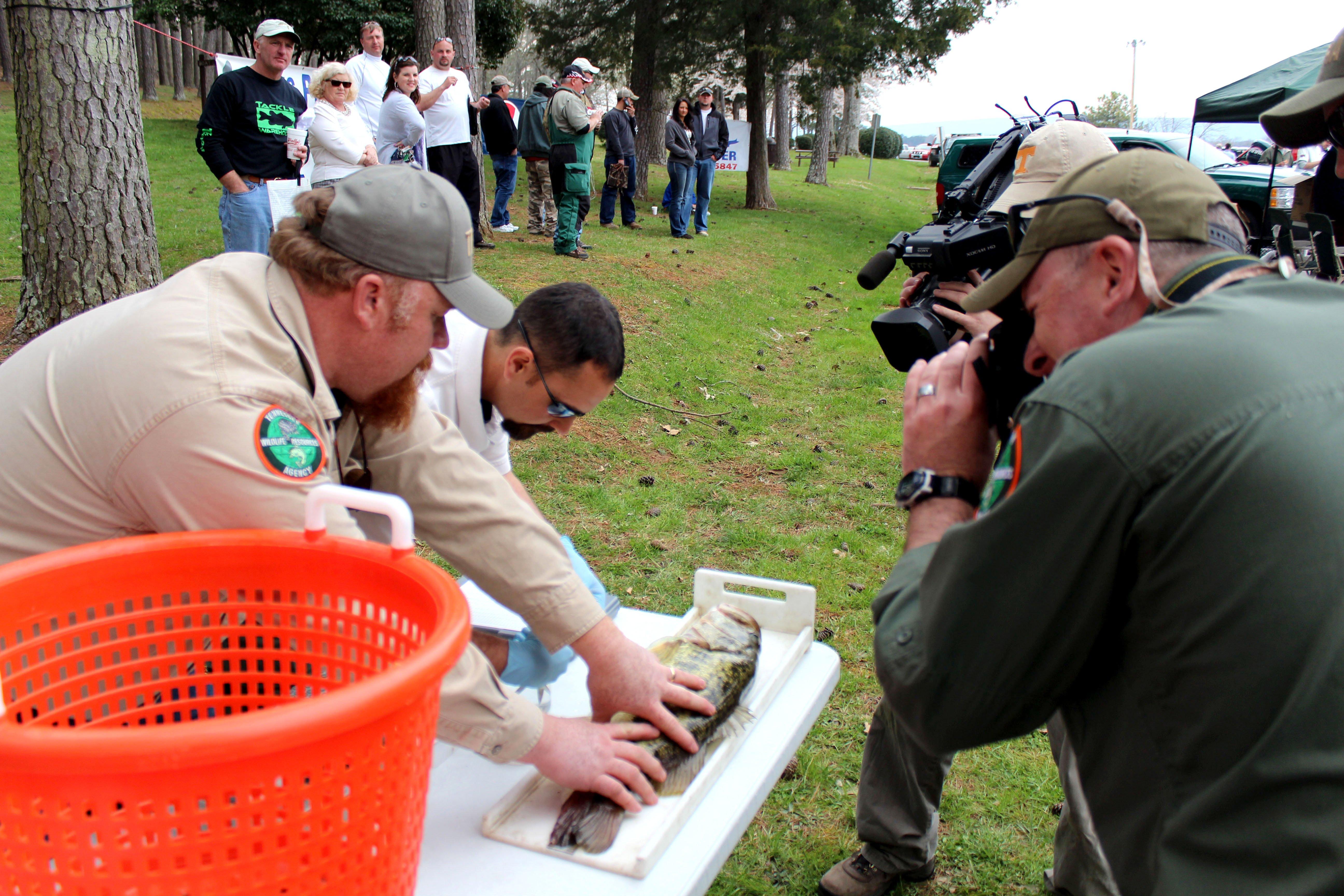
TWRA fisheries biologists Mike Jolley, left, and Brandon Ragland collect tissue samples from fish weighed in during a Chickamauga Lake bass tournament. Photo by Richard Simms.
THE WORD IS OUT
Many other anglers reported largemouths that weighed double-digits. Chickamauga again gained national recognition from the bass fishing community, and through the years, almost every major bass tournament circuit in the country scheduled regular events there.
In 2006, when I created Scenic City Fishing Charters, Inc., there were only one or two other fishing guide businesses on Chickamauga. Now, Scenic City Fishing Charters books for 10 outfits, five of whom are dedicated bass fishing guides. In addition, there are at least 10 other fishing guides on the lake, the majority of whom are also bass guides. And in recent years, many bass fishing professionals, including Jacob Wheeler, ranked as the #1 professional bass angler in the world, moved here so they could call Chickamauga their home lake.
Understandably, bass anglers across the state were a bit jealous, wondering if a Florida bass stocking program would improve the bass fishing in their lakes. About the same time as Keen’s state-record catch, TWRA began Florida bass stocking in Nickajack, Watts Bar, Fort Loudoun and Kentucky lakes, and later added Pickwick and Boone lakes.
In 2016, the Tennessee Fish and Wildlife Commission funded a major expansion of TWRA’s Humboldt Fish Hatchery in western Tennessee. Rather than having to ship in Florida bass fingerlings from other states, the agency geared up to begin producing its own supply of fingerlings in 2017.
“That’s when we cut the umbilical cord with the other states,” said Hunter Henley, TWRA Region I lakes and hatchery manager. “It was a lot of trial and error and problem solving. It was stressful because we had other projects going on. Long hours were put in.”

Author Richard Simms was understandably happy when he caught this 12-plus-pound largemouth while crappie fishing on Chickamauga Lake on Valentine’s Day 2017. Photo by Richard Simms.
DID IT WORK?
In Chickamauga Lake, it took 10 years or more for anglers and biologists to clearly recognize the program was helping. Through DNA testing, biologists realized that the largest bass from the lake were, like Keen’s state-record fish, F-1 hybrids — fish produced when a true Florida bass spawned with a native northern largemouth. It’s called hybrid vigor.
“From our long-term assessment of Chickamauga, it was apparent that the first-generation hybrid offspring (F-1) from a mating pair consisting of a native (northern) parent and a Florida parent were the high performers — meaning the highest growth rates,” said Pat Black, TWRA’s statewide reservoir biologist.
In addition, Black said those fish were actually more aggressive and likely to hit a lure.
“In our regular electrofishing surveys, about 20% of the bass we collected were F-1 hybrids,” he said. “However, when we sampled fish caught in tournaments, we found about 60% of the bass anglers caught were F-1 hybrids.”
Black said that subsequent generations of those fish retain some of the performance characteristics, but it appears to decline through successive generations.
“With this in mind, the metrics we use to assess the progress of a Florida largemouth stocking program is the percent of F-1 hybrids and also the percent of native largemouths,” he said. “Without native bass in the population, there is no possibility of creating the high-quality F-1s.”
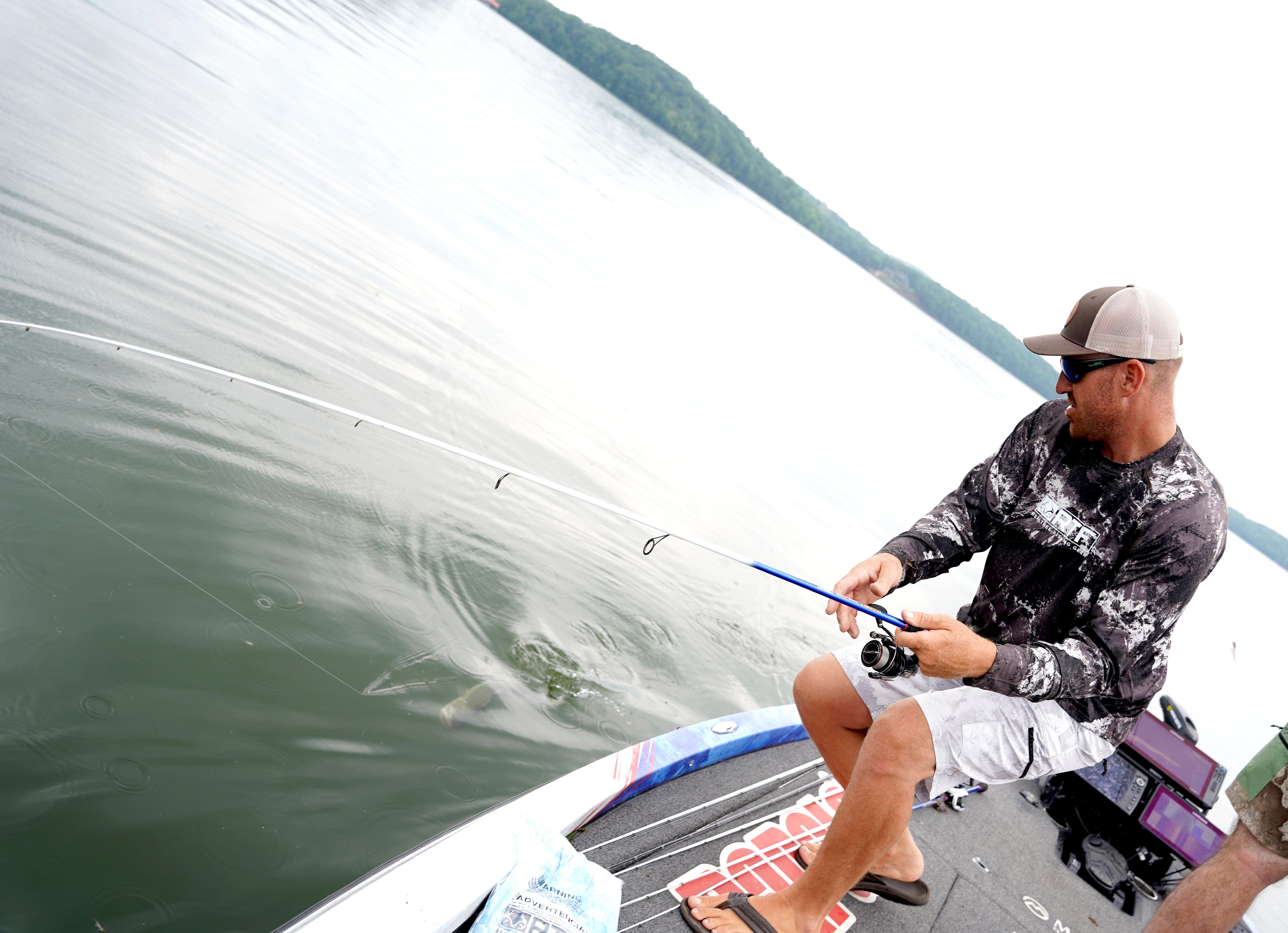
Jacob Wheeler left his home state of Indiana to move to the shores of Chickamauga Lake specifically because of the great bass fishing there. Photo by Realtree.
TWRA Region III fisheries biologist Mike Jolley added, “Contributing factors have likely helped with the success of this program on Chickamauga. It is a large reservoir, with good aquatic vegetation, an ample forage base, adequate size limits on bass, and consistent natural reproduction of bass. All of that has helped create a perfect storm for this very good outcome.”
WHAT’S HAPPENING IN OTHER LAKES
It has been 10 years since the supplemental stockings began in several other Tennessee reservoirs, and anglers are anxious to know the results.
“So far, we haven’t seen a big uptick in the size structure of bass at these locations,” Black said. “It’s important to keep in mind that the F-1 offspring from the initial 2015 stockings are just entering the recreational fishery and, as such, make up a fairly small proportion of the total population. We expect to see more results as subsequent cohorts enter the fishery.”
He added, however, that Watts Bar Lake, immediately upstream of Chickamauga Lake, “is showing great promise.”
“In the 2021 sample (from Watts Bar) we detected 12% F-1 hybrids,” he said. “These fish were still too young at the time to express dramatic growth differences, but that will begin as each cohort of F-1s reaches 4 to 5 years old. The percent of native bass remaining in the system is still at 74%. This means there is a high potential to create new F-1 hybrids for many years to come.”
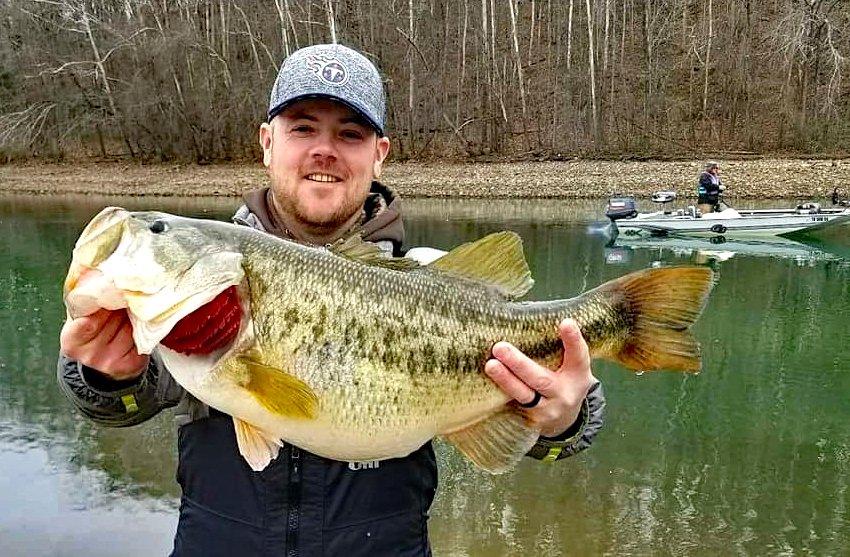
In December 2017, Todd Beaty caught a 14.5-pound Chickamauga largemouth, just a few ounces shy of Gabe Keen’s 2015 state-record largemouth. Contributed photo.
Anecdotally, from my social media pages, I’ve seen more big bass posts from Watts Bar. Local angler Mark Grimsley posted, “Watt Bar is my favorite lake.”
MORE DNA TESTS COMING
Large-scale DNA testing is an expensive process, so TWRA can only afford to test the newly stocked lakes periodically.
Black said from 2015 to 2020 on Kentucky Lake, biologists saw a lake-wide increase in F-1 hybrids from 2% to 5%.
“As of 2020, they had not detected any F-1 hybrids in Fort Loudoun,” he said. “Since this sample was collected only five years after the initial Florida stocking, it is not surprising that we didn’t detect hybridization.”
Likewise, he said 2021 DNA sampling at Nickajack did not detect any F-1 hybrids. The abundance of native fish was only 5%. The rest of the largemouth samples were mostly back-crossed hybrids representing later cohorts.
Nickajack is immediately downstream from Chickamauga, so Black suspects there was already a high degree of Florida bass genetic influence because of Florida genes moving downstream naturally.
“There may still be some growth benefits from the back-crossed bass, but probably not as significant as we would see if there was an abundance of F-1s,” he said. “We will continue to monitor this as well as the others over time.”
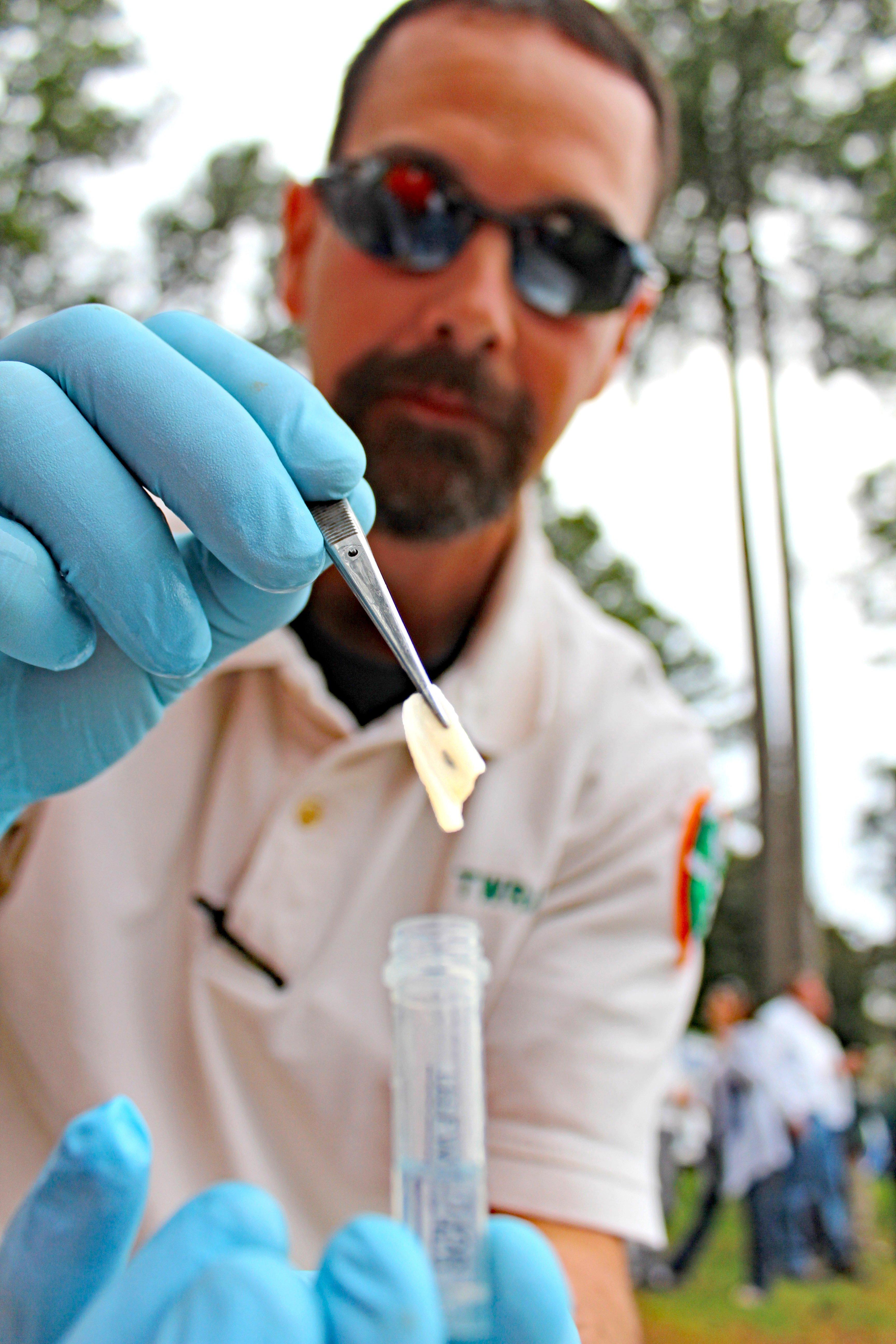
TWRA fisheries biologist Brandon Ragland collects a tissue sample from a Chickamauga largemouth. Photo by Richard Simms.
Black said the next round of genetic assessments is scheduled to happen at Kentucky Lake and Fort Loudoun in 2025, and at Boone, Nickajack and Watts Bar in 2026.
“As a side note, we have been working with Tennessee Tech (University) to establish largemouth bass genetics testing protocols,” he said. “This may give us the opportunity to ramp up our genetics sampling schedule, which was limited to a fixed number of samples per year under our contract with Auburn University.”
MORAL OF THE STORY
Such stockings are a marathon, not a sprint. Even after 10 years, anglers shouldn’t expect major results. But Black and others hope that the next five years will provide clearer direction.
Don’t Miss: The Best Lakes to Catch a 10-Pound Bass This Winter
“We plan to continue stocking at all these locations,” he said. “It is still too early to say with complete certainty whether any location was a success or not. Creating quality or trophy hybrid largemouth bass requires two generations to grow to maturity, just to see the initial results. We are just now reaching that point. It takes patience, but as shown on Chickamauga, the results are worth it.”
Obviously, many anglers hope that Chickamauga won’t be the only Tennessee lake in coming years getting national recognition for great bass fishing. In truth, however, many local anglers aren’t crazy about the publicity, which attracts bass fishermen from across the country. Like anglers everywhere, they are protective and would prefer that their sweet spots remain a secret.
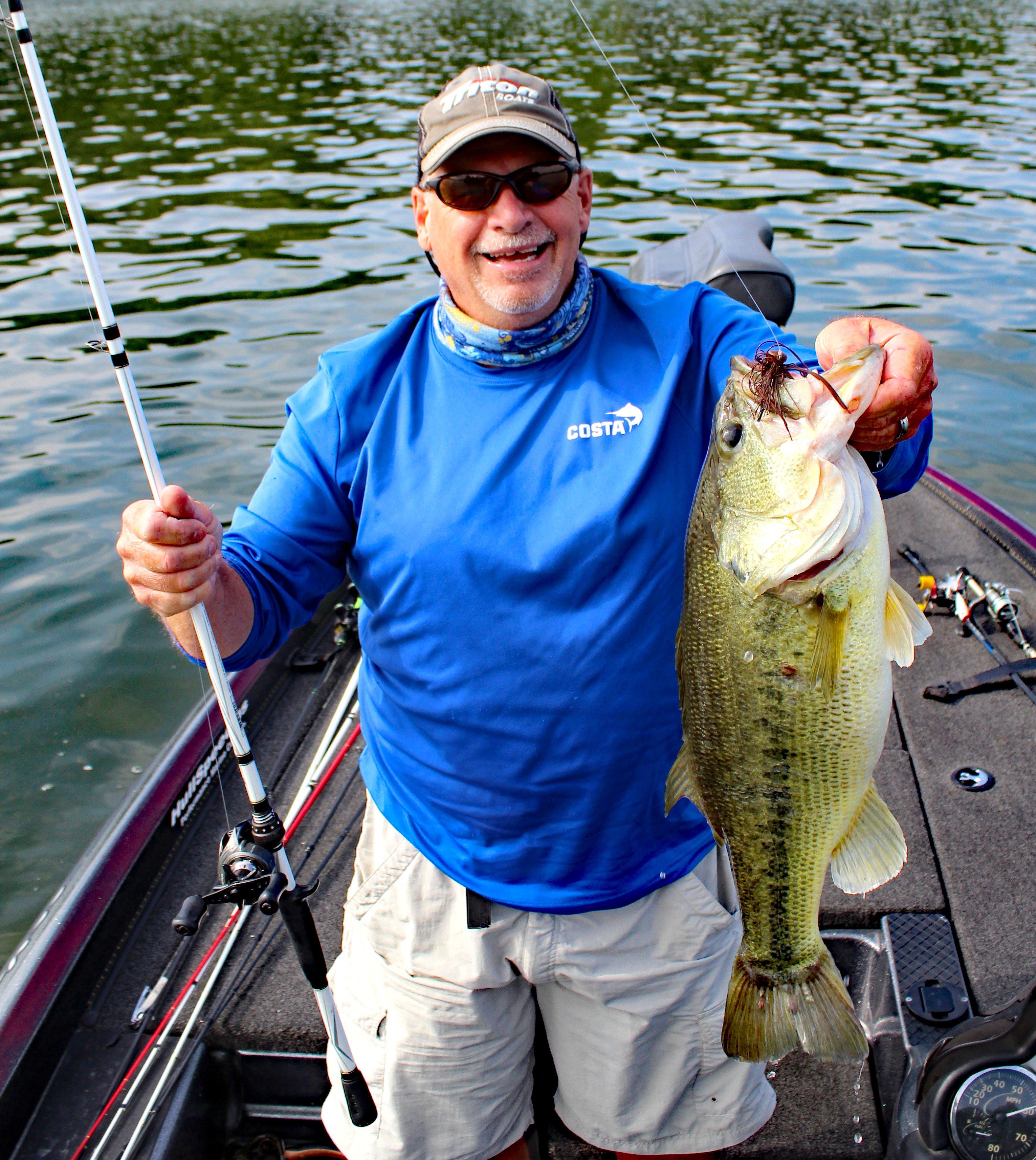
Capt. Ben Hayes, a guide with Scenic City Fishing Charters, is proud to have watched the dramatic evolution of bass fishing on Chickamauga Lake. Photo by Richard Simms.
Tourism officials, however, are happy with TWRA’s work. In 2021, Tennessee Gov. Bill Lee and fishing icon Bill Dance announced a new initiative on Tennessee lakes called the Bill Dance Signature Lakes. Of course, the list of 18 signature lakes includes Chickamauga.
TWRA and the state of Tennessee are investing $15 million in improvements above and below the water at those 18 lakes, which include nine major reservoirs and nine small-venue lakes. Enhancements will include increased stocking rates, habitat and fisheries management, and improved access for fishing and boating.
With the continuing Florida bass program and the Bill Dance Signature Lakes improvements and marketing efforts, odds are anglers everywhere will be reading more about what Tennessee has to offer fishermen.
You can read more about TWRA’s Florida bass stocking Program here.
Editor’s note: From Chattanooga, Tennessee, Capt. Richard Simms is the owner of Scenic City Fishing Charters, Inc. He began his outdoor career as a Tennessee game warden, later choosing journalism and guiding as his chosen professions. Check out his book, "An Outdoor State of Mind." You can contact him at Richard@ScenicCityFishing.com.










































